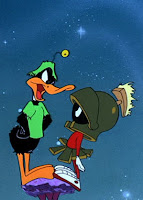Duck Dodgers in the 24 ½th Century
Deconstructing Daffy Duck
 |

 |
| Victory at what cost? The irony in this concluding scene runs as strong as any of the anti-war satire in Stanley Kubrick's famous Dr. Strangelove (1964). |
A friend at the International Move Database (IMDb) Classic
Film message board responded in dismay when I proposed launching this Duck Dodgers series. He said he saw no value in deconstructing Daffy Duck. I completely
understand that sentiment.
Viewed simply as a comedy, Duck Dodgers in the 24 ½th Century (1953) is one of the great
animated shorts. It succeeds in delivering the laughs. And it looks
fantastic while doing so.
But I’m diving into the deeper waters nevertheless.
I’ve read enough of Chuck Jones’ writings to know that this guy was no
intellectual slouch. In addition to being very funny, Jones was
politically aware, artistically sensitive, and philosophically astute. He
wanted his movies to have resonance.
A Political
Interpretation
The United States
dropped atomic bombs on Hiroshima and Nagasaki Soviet Union
detonated a nuclear bomb in 1949. Then the United States
 |
| To quote the final line of The Bridge on the River Kwai, "Madness! Madness!" Mutually assured destruction in Duck Dodgers. |
With these contemporary events in mind, it’s difficult not to see
an arms race subtext in Duck Dodgers. As Duck Dodgers and Marvin (the two Planet X superpowers) face off, their weapons get progressively more
destructive. With these two at the controls, there is no deterrence
effect from an assumption of mutually assured destruction. They blithely
destroy the world, with Daffy cackling as he pulls the lever.
I think we can assume that Acme Products continues to
receive billions of dollars in no-bid contracts from the Pentagon to this day.
A Metaphysical
Speculation
 |
| Dangling from the Statue of Liberty Liberty in Alfred Hitchcock's Saboteur (1942). |
I love literal cliffhangers—movies that build to a climax
where the lead characters literally hang from a great height, dangling over an
abyss.
This image is one of the great existential metaphors.
It reminds us that we’re all hanging over a metaphorical abyss—it’s the nature
of life.
This metaphor is operating when a villain
 |
| Clinging to the side of Mount Rushmore in Hitchcock's North by Northwest (1959). |
clings to the Statue of Liberty in Saboteur (1942) and when Eva Marie Saint clings to Cary Grant’s hand
on the edge of Mount Rushmore in North by Northwest (1959) , but I don’t
think you can surpass the latent power of the image than when you place the
characters dangling over infinite space. And to work most effectively as
a metaphor, you leave them there with no resolution, suspended forever.
This is exactly what Duck Dodgers does. It’s
double-edged. Close one eye to the comedy, and you’re left with a bleak
and frightening vision.
Iris out on Porky, and the carnival music roars back
reminding us that it’s all just good cartoon fun.
That’s all there is, folks!
 |
| Above him, Duck Dodgers proclaims, "This planet is hereby claimed for the Earth!" "B-b-big deal," says Porky. |
Reference Sources
Chuck Amuck by Chuck Jones
Chuck Reducks by Chuck Jones
Hollywood Cartoons by Michael Barrier
Looney Tunes: The Ultimate Visual Guide by Jerry Beck
Warner Bros. Animation Art by Jerry Beck and Will Friedwald
7 Minutes by Norman M. Klein
That's All Folks by Steve Schneider
Stepping Into the Picture by Robert J. McKinnon
Stepping Into the Picture by Robert J. McKinnon
Looney Tunes Golden Collection, Volume One DVD set, Duck Dodgers commentary by Michael Barrier
Friends at the IMDb Classic Film message board including Rollo Treadway, Chloe Joe Fassbender, Illtdesq, and Fish Beauty
... and an occasional sneak glance at Wikipedia entries (but always double-checking everything!)
Watch Duck Dodgers...
Watch Duck Dodgers...
Purchase Looney Tunes Golden Collection, Volume One DVD set at Amazon or Barnes & Noble.
Rent Disc Two of Looney Tunes Golden Collection, Volume One DVD set at Netflix or other rental service.
© 2011 Lee Price
Rent Disc Two of Looney Tunes Golden Collection, Volume One DVD set at Netflix or other rental service.
© 2011 Lee Price











































